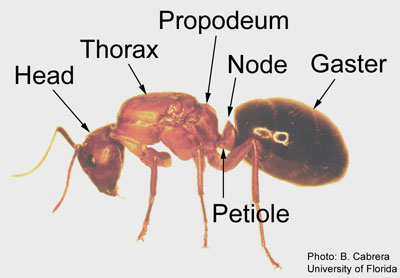
An invertebrate animal of the class Insecta of the phylum Arthropoda. Like other arthropods, an insect has a hard outer covering, or exoskeleton, a segmented body, and jointed legs. Adult insects typically have wings and are the only flying invertebrates. 1
The body of the typical adult insect is divided into three distinct parts, the head, thorax, and abdomen. The head bears three pairs of mouthparts, one pair of compound eyes, three simple eyes (ocelli), and one pair of jointed sensory antennae. The thorax is divided into three segments, each with a pair of jointed legs, and bears two pairs of wings. The abdomen has posterior appendages associated with reproduction. The exoskeleton is composed of a horny substance called chitin. 2
Insects breathe through a complex network of air tubes (tracheae) that open to the outside through a series of small valved apertures (spiracles) along the sides of the body. In chewing insects the digestive system includes a muscular gizzard that is lacking in sucking insects. The simple circulatory system is composed of a tubular heart that pumps blood forward into the head, from which it diffuses through the tissues and back into the heart. The aquatic larvae of many insects breathe by means of external gills; some very primitive species breathe directly through the body wall. 3
Insect Species
There are about 900,000 known insect species, three times as many as all other animal species together, and thousands of new ones are described each year. They are commonly grouped in 27 to 32 orders, depending upon the classification used. The largest order is that of the beetles (Coleoptera). Next, in order of size, are the moths and butterflies (Lepidoptera); the wasps, ants, and bees (Hymenoptera); and the flies and mosquitoes (Diptera). Other major orders are the true bugs (Hemiptera); the cicadas, aphids, and scale insects (Homoptera); and the roaches, mantids, and grasshoppers (Orthoptera).






























